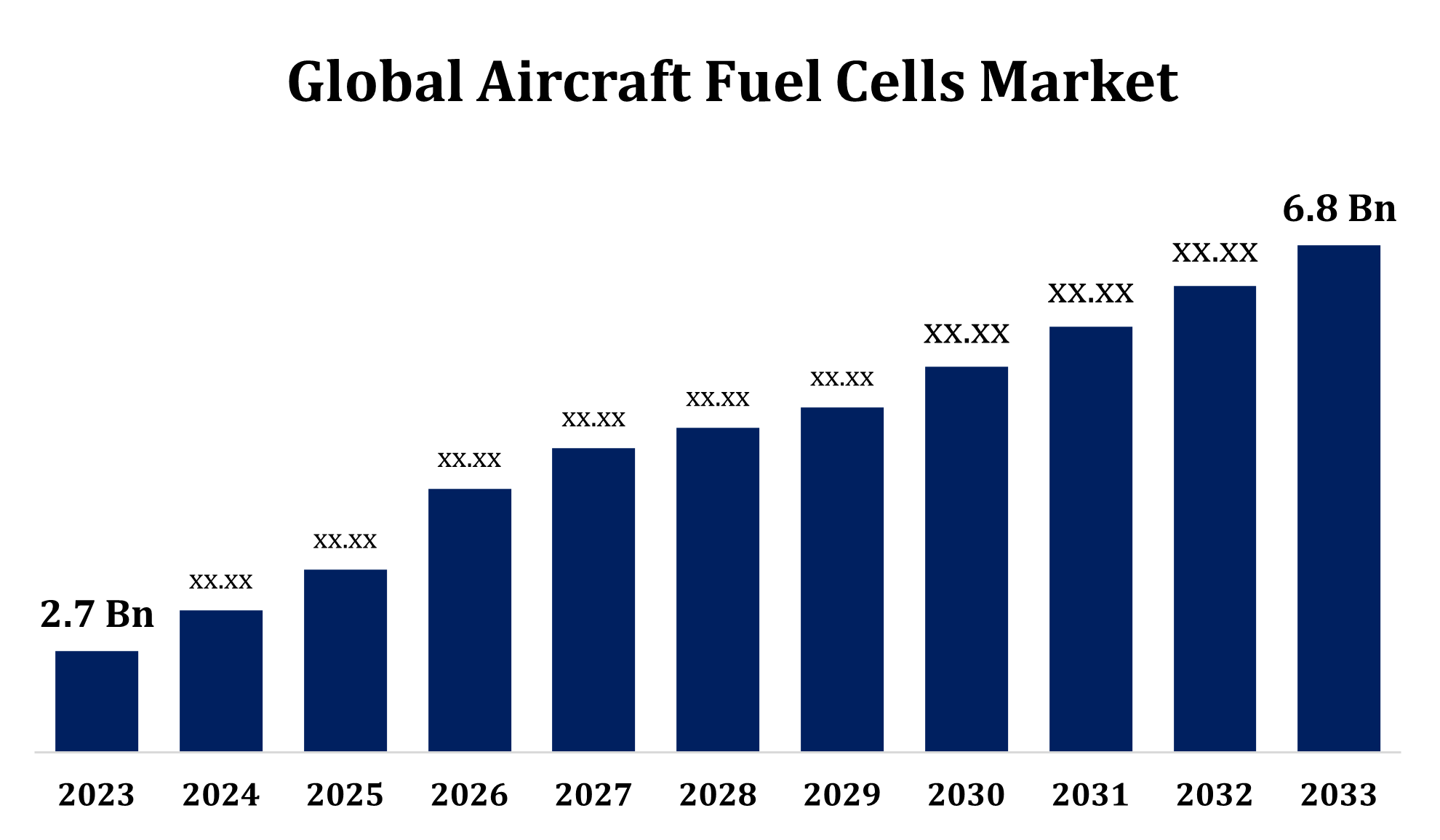Global Aircraft Fuel Cells Market Size To Worth USD 6.8 Billion By 2033 | CAGR of 9.68%
Category: Aerospace & DefenseGlobal Aircraft Fuel Cells Market Size To Worth USD 6.8 Billion By 2033
According to a research report published by Spherical Insights & Consulting, the Global Aircraft Fuel Cells Market Size to Grow from USD 2.7 Billion in 2023 to USD 6.8 Billion by 2033, at a Compound Annual Growth Rate (CAGR) of 9.68% during the forecast period.

Get more details on this report -
Browse key industry insights spread across 257 pages with 117 Market data tables and figures & charts from the report on the "Global Aircraft Fuel Cells Market Size, Share, and COVID-19 Impact Analysis, by Fuel Type (Hydrogen, Hydrocarbon, Others), Power Output (0-100kW, 100 kW- 1MW, 1MW & Above), Aircraft Type (Fixed-Wing, Rotary Wing, UAVs, AAMs), and By Region (North America, Europe, Asia-Pacific, Latin America, Middle East, and Africa), Analysis and Forecast 2023 - 2033." Get Detailed Report Description Here: https://www.sphericalinsights.com/reports/aircraft-fuel-cells-market
The aircraft fuel cells market is witnessing rapid growth, fueled by the rising demand for sustainable and energy-efficient aviation solutions. Fuel cells, which generate electrical energy from chemical reactions, are emerging as a promising alternative to traditional aviation fuel systems, offering enhanced efficiency and reduced emissions. Key factors driving this growth include technological advancements in fuel cells, a growing emphasis on minimizing aviation's carbon footprint, and supportive government initiatives. Hydrogen fuel cells, in particular, are gaining momentum due to their potential to enable zero-emission flights. Increased investments in research and development, collaborations between the aviation and energy sectors, and the expansion of green hydrogen infrastructure further bolster market progress. Although challenges such as high initial costs and limited infrastructure persist, ongoing innovation continues to unlock new growth opportunities.
Aircraft Fuel Cells Market Value Chain Analysis
The aircraft fuel cells market value chain comprises several critical stages. It begins with raw material suppliers who provide essential components such as membranes, catalysts, and hydrogen storage materials. These are then processed by specialized manufacturers into fuel cell systems, with a focus on technologies like proton exchange membrane (PEM) and solid oxide fuel cells (SOFC). System integrators adapt these systems for aviation-specific applications, ensuring they meet aircraft design requirements. Aircraft manufacturers and operators serve as end-users, utilizing fuel cells to enhance energy efficiency and minimize emissions. The value chain is supported by hydrogen production and distribution networks, vital for fueling operations. Additionally, research institutions, technology developers, and regulatory bodies play key roles in driving innovation, setting standards, and addressing challenges such as cost, weight, and infrastructure limitations to enable broader adoption.
Aircraft Fuel Cells Market Opportunity Analysis
The aircraft fuel cells market offers substantial opportunities, driven by the global shift toward sustainable aviation and strict emission reduction targets. Hydrogen fuel cells are emerging as a zero-emission alternative to traditional fuel systems, paving the way for innovative aircraft designs and retrofitting options for existing fleets. Advances in lightweight materials and efficient fuel cell technologies are enhancing their viability across commercial, regional, and unmanned aircraft segments. Rapidly growing markets in Asia-Pacific and the Middle East, fueled by increasing air traffic and government initiatives supporting green energy, present attractive growth prospects. Additionally, partnerships between aerospace companies and hydrogen suppliers are accelerating the development of reliable hydrogen production and distribution networks. Despite challenges such as high costs and scalability, ongoing innovation and investment continue to drive widespread adoption and long-term growth.
Advancements in fuel cell technology and enhanced cost efficiency are driving the growth of the aircraft fuel cells market. Innovations in hydrogen fuel cells, such as lightweight designs and improved efficiency, are making them more practical for aviation applications. These developments address key challenges like energy density and operational durability, enabling fuel cells to power a range of aircraft, from unmanned aerial vehicles to commercial jets. At the same time, decreasing production costs and scalable manufacturing processes are fostering wider adoption. The market is further bolstered by supportive government policies, investments in green hydrogen infrastructure, and a growing emphasis on decarbonizing aviation. Although obstacles like infrastructure limitations and high upfront costs remain, ongoing innovation continues to open new avenues for sustainable aviation powered by fuel cells.
High initial costs for developing and integrating fuel cells remain a major obstacle, particularly in achieving commercial scalability. Market growth is further hindered by infrastructure limitations, including insufficient hydrogen production, storage, and refueling networks. Technical challenges such as designing lightweight systems, ensuring durability in extreme conditions, and maintaining high energy density also persist. The limited availability and high production costs of green hydrogen add to these difficulties, impacting the feasibility of fuel cell-powered aviation. Additionally, regulatory complexities and the need for standardization in fuel cell technology create further barriers. Competition from other sustainable aviation solutions, such as battery-electric and hybrid propulsion systems, adds pressure, making market penetration more challenging. Overcoming these issues will require coordinated efforts, innovation, and significant investment.
Insights by Aircraft Type
The UAVs segment accounted for the largest market share over the forecast period 2023 to 2033. Fuel cells provide distinct advantages over traditional batteries, including higher energy density, lightweight construction, and extended operational range, making them well-suited for UAV applications across military, commercial, and research sectors. The growing use of UAVs for surveillance, delivery services, disaster response, and environmental monitoring is a key driver for this technology. Governments and private entities are actively investing in hydrogen fuel cell advancements to improve UAV performance while lowering carbon emissions. Progress in miniaturized fuel cell systems and hydrogen storage technologies is further accelerating adoption within this segment. While challenges such as high costs and limited refueling infrastructure remain, ongoing innovation and the expanding range of UAV applications are driving significant growth in this market.
Insights by Power Output
The 0-100 kW segment accounted for the largest market share over the forecast period 2023 to 2033. The 0-100 kW power range meets the energy demands of lightweight applications, providing an efficient and eco-friendly alternative to traditional fuel systems. Rising interest in clean propulsion technologies for unmanned aerial systems, regional aircraft, and hybrid-electric propulsion systems is driving the adoption of fuel cells in this segment. Advancements in compact fuel cell designs, enhanced energy densities, and decreasing production costs are further improving accessibility. The segment is also benefiting from increased government support for sustainable aviation and the development of hydrogen infrastructure. Although scaling production remains a challenge, the 0-100 kW segment offers significant growth potential as the aviation industry focuses on lightweight and energy-efficient solutions.
Insights by Fuel Type
The hydrogen segment accounted for the largest market share over the forecast period 2023 to 2033. Hydrogen fuel cells present a compelling solution for reducing carbon emissions and achieving the aviation industry’s sustainability objectives. With growing emphasis from governments and aviation companies on minimizing environmental impact, hydrogen fuel cells are increasingly being adopted for commercial and regional aircraft, as well as UAVs. Progress in hydrogen production, storage, and refueling infrastructure is addressing key adoption challenges. The introduction of green hydrogen, derived from renewable energy sources, further enhances the segment’s environmental benefits. As hydrogen-powered aircraft gain traction among industry leaders, the segment is set for substantial growth, driven by strategic collaborations, increased investments, and supportive regulatory policies aimed at decarbonizing aviation.
Insights by Region

Get more details on this report -
North America is anticipated to dominate the Aircraft Fuel Cells Market from 2023 to 2033. The United States and Canada, home to prominent aerospace companies and research institutions, are making significant investments in hydrogen fuel cell development to achieve emission reduction targets. Government initiatives, including subsidies for clean energy projects and funding for hydrogen infrastructure, are driving market expansion. With a well-established aviation industry and increasing demand for eco-friendly solutions, the region is embracing fuel cell technology across commercial, military, and unmanned aircraft. Moreover, partnerships between aerospace manufacturers and hydrogen suppliers are propelling advancements in fuel cell innovation and adoption.
Asia Pacific is witnessing the fastest market growth between 2023 to 2033. Japan and South Korea are at the forefront of hydrogen infrastructure development, while China prioritizes scaling fuel cell production and adoption across various industries. Government initiatives, such as subsidies and strategic policies, are accelerating progress in aviation fuel cell technology. Collaborations between aerospace manufacturers and renewable energy companies are further fueling innovation in the region. Despite persistent challenges like limited infrastructure and high costs, continued investments and regional partnerships are positioning Asia-Pacific as a pivotal market for aircraft fuel cells.
Recent Market Developments
- In September 2021, SFC Energy AG has partnered with Bharat Electronics and FC TecNrgy to investigate hydrogen fuel cell-based energy generation solutions for off-grid power supply. This collaboration targets applications in homeland security, civil protection, and defense.
Major players in the market
- Ballard Power Systems
- Air Products
- Iwatani
- Showa Denko
- Plug Power
- Doosan Fuel Cell
- Linde
- Nuvera Fuel Cells
- Ceres Power
- Hydrogenics
- Cummins
- Bloom Energy
- SAFT
- SFC Energy
- Praxair
Market Segmentation
This study forecasts revenue at global, regional, and country levels from 2023 to 2033.
Aircraft Fuel Cells Market, Fuel Type Analysis
- Hydrogen
- Hydrocarbon
- Others
Aircraft Fuel Cells Market, Power Output Analysis
- 0-100kW
- 100 kW- 1MW
- 1MW & Above
Aircraft Fuel Cells Market, Aircraft Type Analysis
- Fixed-Wing
- Rotary Wing
- UAVs
- AAMs
Aircraft Fuel Cells Market, Regional Analysis
- North America
- US
- Canada
- Mexico
- Europe
- Germany
- Uk
- France
- Italy
- Spain
- Russia
- Rest of Europe
- Asia Pacific
- China
- Japan
- India
- South Korea
- Australia
- Rest of Asia Pacific
- South America
- Brazil
- Argentina
- Rest of South America
- Middle East & Africa
- UAE
- Saudi Arabia
- Qatar
- South Africa
- Rest of the Middle East & Africa
About the Spherical Insights & Consulting
Spherical Insights & Consulting is a market research and consulting firm which provides actionable market research study, quantitative forecasting and trends analysis provides forward-looking insight especially designed for decision makers and aids ROI.
Which is catering to different industry such as financial sectors, industrial sectors, government organizations, universities, non-profits and corporations. The company's mission is to work with businesses to achieve business objectives and maintain strategic improvements.
CONTACT US:
For More Information on Your Target Market, Please Contact Us Below:
Phone: +1 303 800 4326 (the U.S.)
Phone: +91 90289 24100 (APAC)
Email: inquiry@sphericalinsights.com, sales@sphericalinsights.com
Contact Us: https://www.sphericalinsights.com/contact-us
Need help to buy this report?